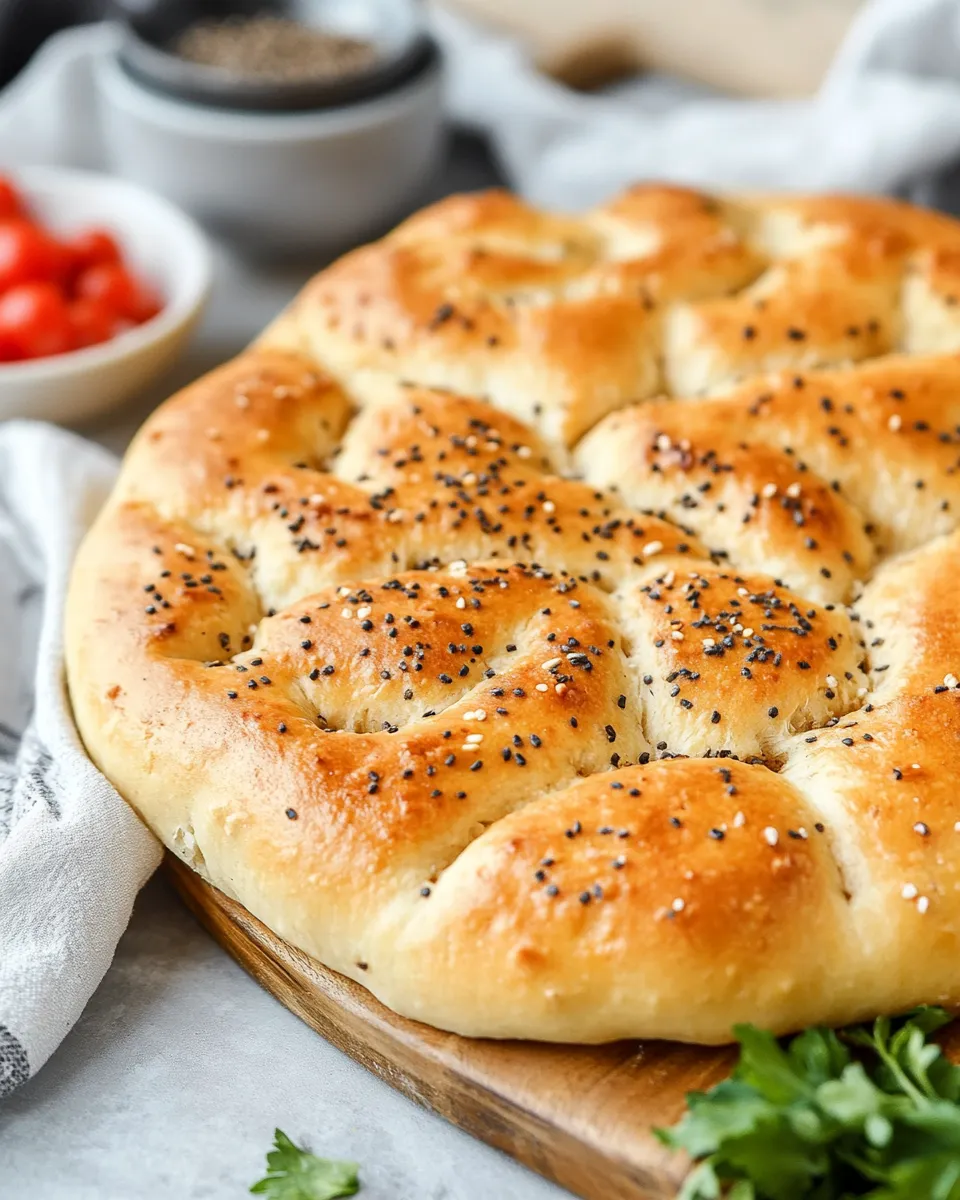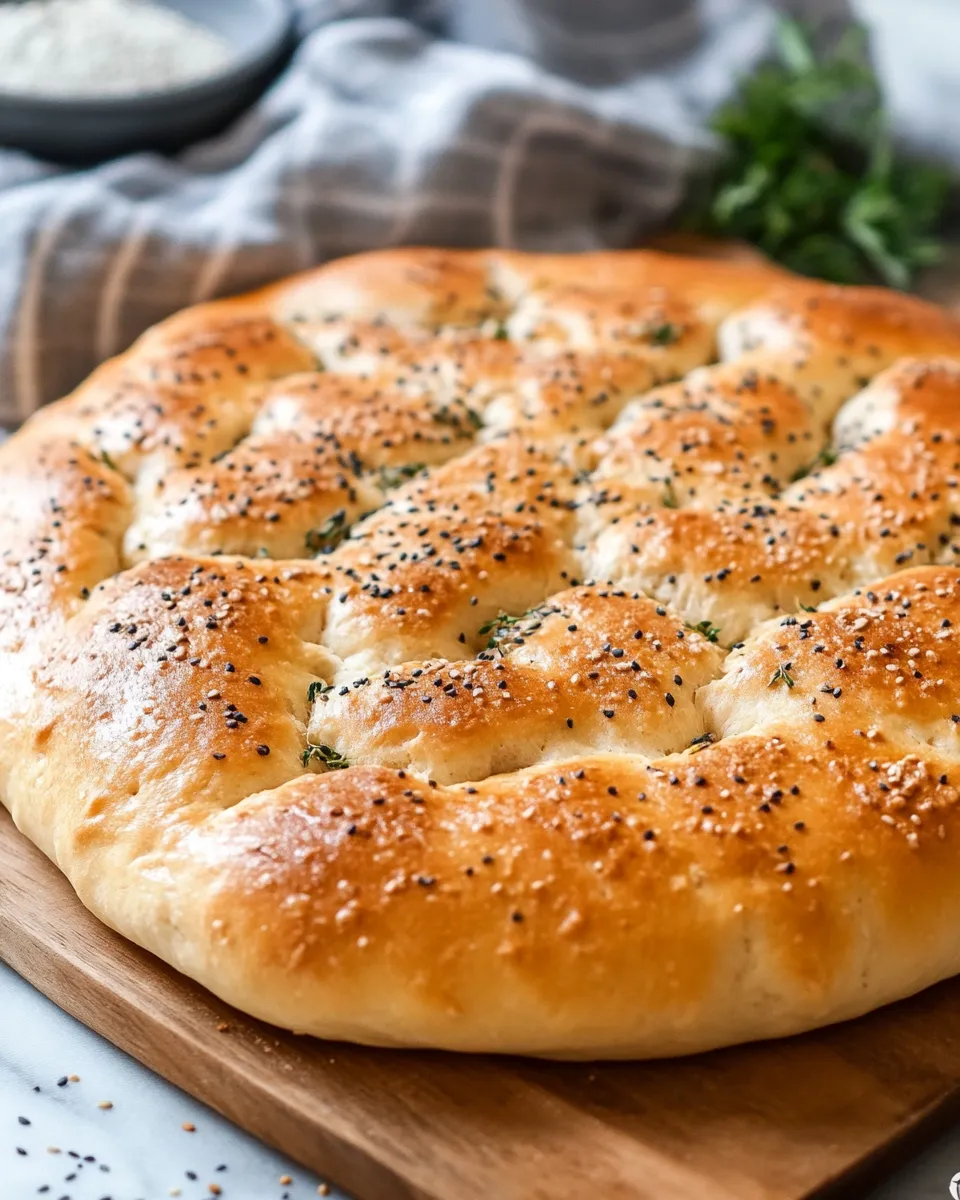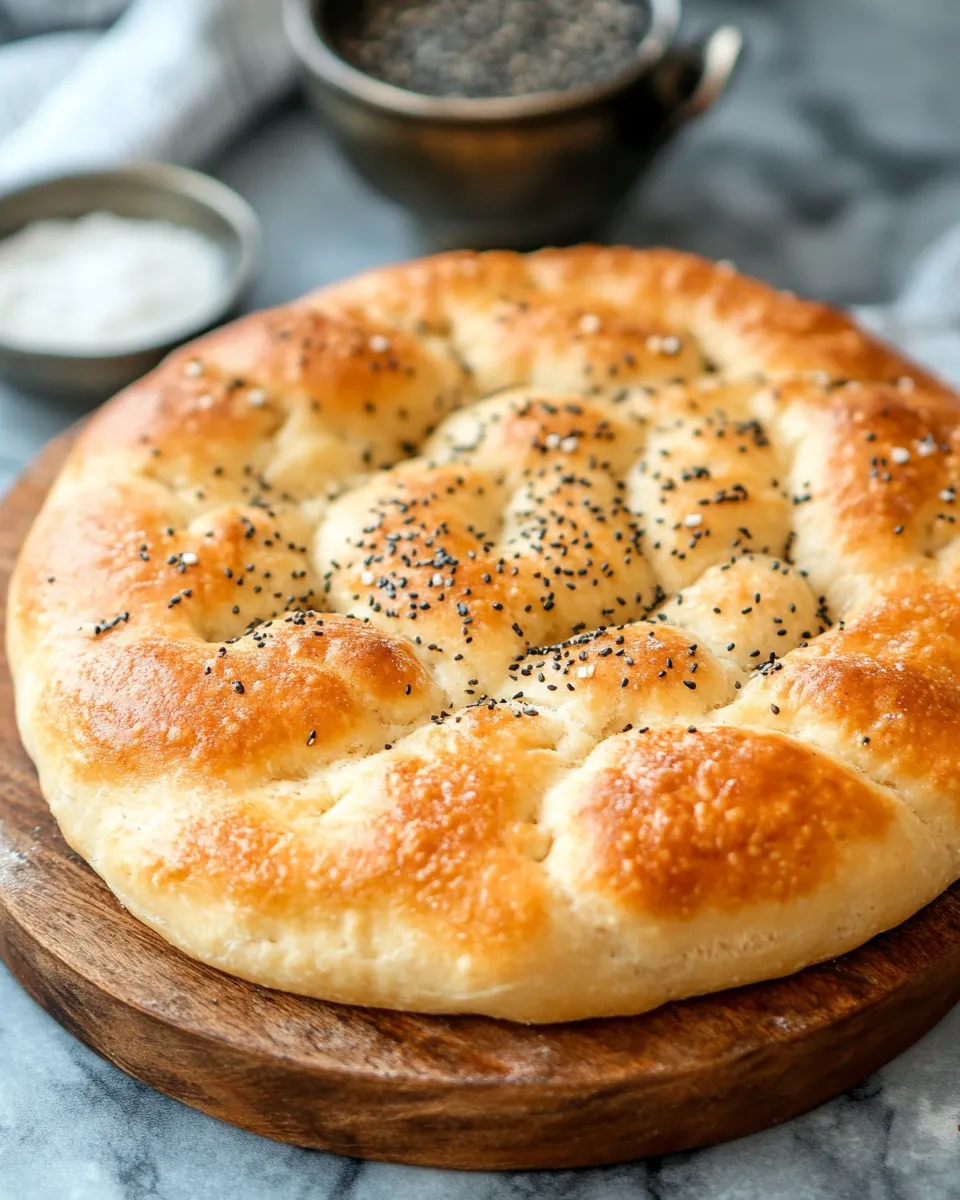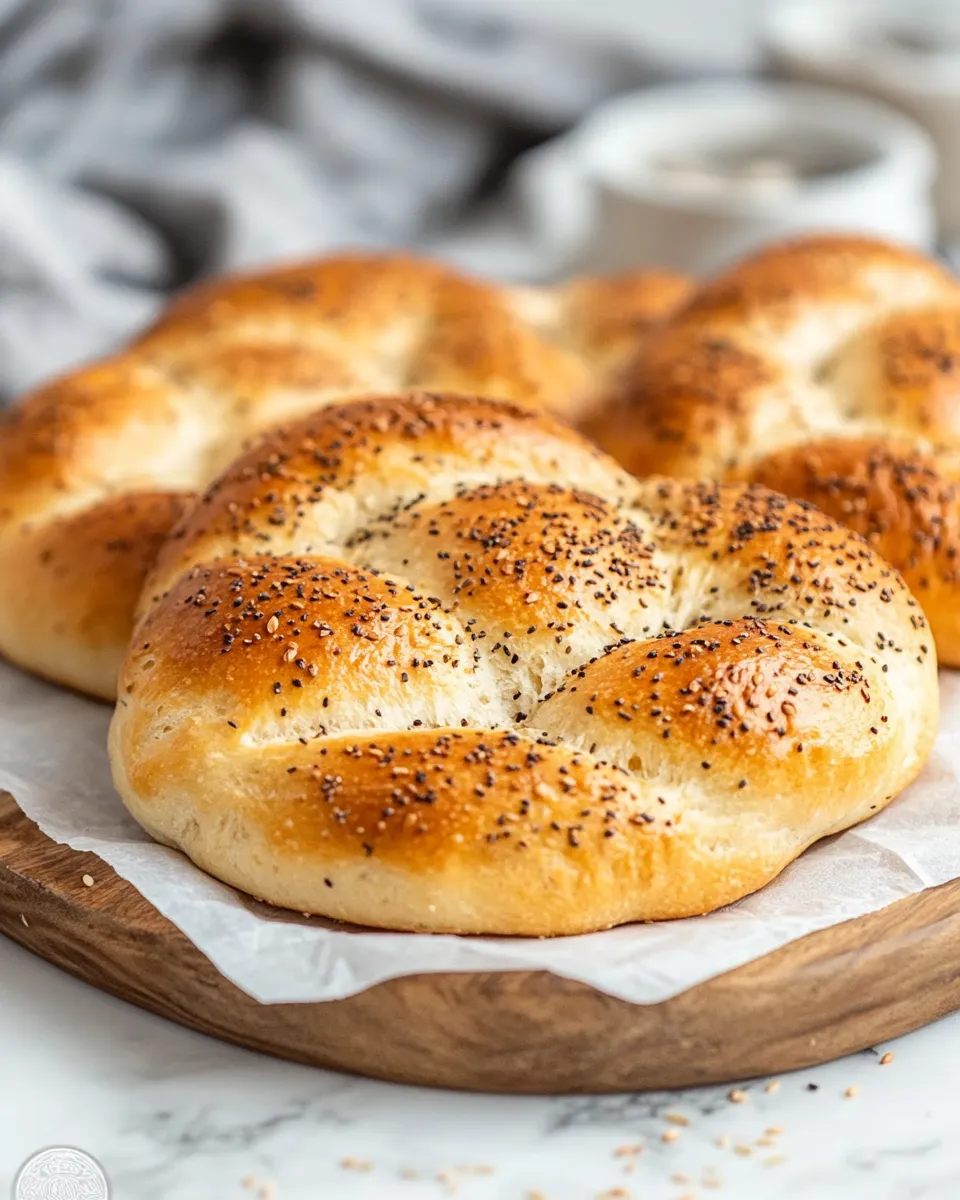When Ramadan rolls around, one of the most beloved traditions is breaking fast with delicious food.
Among the many treats to savor, Turkish Ramadan Bread, known as Ramazan Pidesi, holds a special place in the hearts (and stomachs) of many.
This soft, airy bread is perfect for tearing into and pairing with your favorite dips or dishes.
Whether you’re enjoying it with a hearty soup or simply drizzled with olive oil, this bread will elevate your iftar experience.
Let’s dive into how to make this delightful bread.
Why This Recipe Is a Must-Try

This Turkish Ramadan Bread is not just any bread; it’s a cultural delight that brings communities together.
Its unique flavor and fluffy texture make it perfect for any meal.
The warm, aromatic bread is especially comforting after a day of fasting.
Plus, this recipe is simple to follow, so even if you’re new to baking, you can achieve great results.
By using just a handful of ingredients, you can create a stunning bread that will wow your family and friends.
Ingredients
To make this delicious Ramazan Pidesi, you’ll need the following ingredients:
- 3 cups (360 g) all-purpose flour
- 1 ½ teaspoons salt
- 1 tablespoon granulated sugar
- 1 teaspoon instant yeast
- 1 cup (240 ml) warm milk
- ¼ cup (60 ml) extra virgin olive oil, or melted butter/ghee, or vegetable oil
These ingredients combine to create a soft and flavorful loaf that is perfect for sharing during Ramadan.
How To Make Turkish Ramadan Bread (Ramazan Pidesi)

Making Ramazan Pidesi is a straightforward process that will fill your home with mouth-watering aromas.
Let’s break it down step-by-step.
Step 1: Prepare the Dough
Start by gathering all your ingredients.
In a large mixing bowl, combine the all-purpose flour, salt, sugar, and instant yeast.
Mix them gently with a whisk to ensure everything is evenly distributed.
Step 2: Add Wet Ingredients
Next, warm the milk to around body temperature.
You can do this in a small saucepan or microwave.
It needs to be warm but not hot; you don’t want to kill the yeast! Add the warm milk and extra virgin olive oil (or your choice of melted butter/ghee or vegetable oil) to the dry ingredients.
Using a wooden spoon or your hands, mix until a cohesive dough forms.
Step 3: Knead the Dough
Turn your dough out onto a lightly floured surface.
Knead it for about 8-10 minutes, or until it becomes smooth and elastic.
This step is crucial because it helps develop the gluten, making your bread wonderfully chewy!
Step 4: Let It Rise
Once your dough is kneaded, place it in a lightly greased bowl.
Cover it with a clean kitchen towel or plastic wrap and let it rest in a warm place for about 1-2 hours, or until it has doubled in size.
Step 5: Shape the Bread
After the dough has risen, gently punch it down to release the air.
Turn it out onto a floured surface again and divide it into 2-4 equal pieces, depending on how large you want your bread to be.
Shape each piece into a round ball and then flatten it gently with your hands.
Use your fingers to create indentations and shapes on top of the bread for a beautiful finish.
Step 6: Final Rise
Transfer the shaped dough onto a baking sheet lined with parchment paper.
Cover it again with a towel and let it rise for another 30-60 minutes.
Step 7: Preheat the Oven
While your dough is rising, preheat the oven to 425°F (220°C).
This high temperature is essential for creating that perfect crust.
Step 8: Bake the Bread
Once the dough has risen for the second time, it’s time to bake! If you like, you can brush the tops with a little more olive oil and sprinkle them with sesame seeds for added flair and flavor.
Place the baking sheet in the oven and bake for about 15-20 minutes, or until the bread is golden brown and sounds hollow when tapped.
Step 9: Cool and Serve
Remove the bread from the oven and let it cool on a wire rack for a few minutes before serving.
This bread is best enjoyed warm, especially with your favorite dips or alongside soups and stews.
Expert Tips
Here are some tips to ensure your Turkish Ramadan Bread turns out perfectly:
- Make sure your milk is not too hot when adding it to the yeast; it should be warm to the touch.
- For a richer flavor, you can substitute half the water with yogurt in the dough.
- If you prefer a softer crust, cover the bread with a kitchen towel immediately after baking.
- Experiment with toppings like nigella seeds or chopped herbs before baking for added flavor.
Variations and Customizations

Feel free to customize your Ramazan Pidesi to suit your taste.
Here are some ideas:
- Add minced garlic or chopped fresh herbs like parsley and dill to the dough for a flavorful twist.
- Mix in some olives, sun-dried tomatoes, or cheese before shaping the bread for a savory variation.
- Try different flours like whole wheat or a blend of whole wheat and all-purpose flour for a more nutritious option.
- Top the bread with za’atar or spices before baking for a unique flavor profile.
How to Store Leftovers
If you have any leftovers (though they may not last!), store them in an airtight container at room temperature for up to 2 days.
For longer storage, you can freeze the bread.
Just wrap it tightly in plastic wrap and then place it in a freezer-safe bag.
When you’re ready to eat, thaw at room temperature and warm it in the oven.
FAQ
Can I make Turkish Ramadan Bread in advance?
Absolutely! You can prepare the dough a day ahead.
Let it rise in the fridge overnight, then shape and bake it on the day you want to serve it.
Is it possible to use whole wheat flour?
Yes, you can use whole wheat flour or a mix of whole wheat and all-purpose flour.
Just note that the texture may be a bit denser compared to using only all-purpose flour.
Can I add toppings to my Ramadan Bread?
Definitely! Toppings like sesame seeds, nigella seeds, or even fresh herbs can enhance the flavor of your bread.
Just sprinkle them on top before baking.
What can I serve with Turkish Ramadan Bread?
Turkish Ramadan Bread pairs wonderfully with hummus, tzatziki, or any type of soup or stew.
You can also enjoy it with olive oil and balsamic vinegar for a tasty dip.
Conclusion
There you have it! An easy and delicious recipe for Turkish Ramadan Bread (Ramazan Pidesi) that will surely impress your family and friends.
With its soft texture and delightful flavor, this bread brings a touch of tradition to your Ramadan table.
Whether you’re enjoying it at iftar or as a snack during the day, this homemade bread is sure to be a hit.
So go ahead, gather your ingredients, and start baking a little piece of Turkey in your kitchen!

Turkish Ramadan Bread (Ramazan Pidesi)
Equipment
- Mixing Bowl
- Baking Sheet
- Whisk
- Wooden Spoon
Ingredients
Dry Ingredients
- 3 cups All-purpose flour 360 g
- 1.5 teaspoons Salt
- 1 tablespoon Granulated sugar
- 1 teaspoon Instant yeast
Wet Ingredients
- 1 cup Warm milk 240 ml
- 0.25 cup Extra virgin olive oil or melted butter/ghee/vegetable oil (60 ml)
Instructions
- Step 1: In a large mixing bowl, combine the all-purpose flour, salt, sugar, and instant yeast. Mix gently with a whisk.
- Step 2: Warm the milk to around body temperature and add it along with the olive oil to the dry ingredients. Mix until a cohesive dough forms.
- Step 3: Knead the dough on a lightly floured surface for about 8-10 minutes until smooth and elastic.
- Step 4: Place the kneaded dough in a greased bowl, cover, and let it rise in a warm place for 1-2 hours until doubled in size.
- Step 5: Punch down the dough, divide it into 2-4 pieces, shape into balls, and flatten gently. Create indentations on top.
- Step 6: Transfer to a baking sheet lined with parchment paper, cover, and let rise for another 30-60 minutes.
- Step 7: Preheat the oven to 425°F (220°C).
- Step 8: Bake for 15-20 minutes until golden brown and sounds hollow when tapped. Optionally brush with olive oil and sprinkle with sesame seeds before baking.
- Step 9: Let cool on a wire rack for a few minutes before serving.






